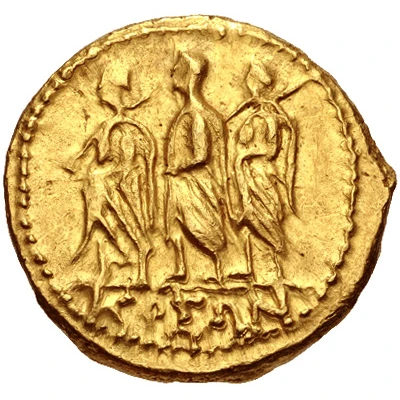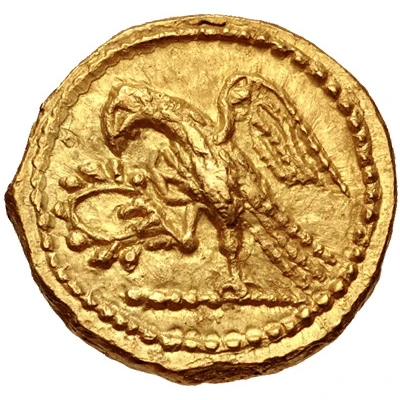


© Classical Numismatic Group, Inc.
Gold Stater Koson type 44 BC - 42 BC
| Gold | 8.5 g | 19 mm |
| Issuer | Uncertain Dacian tribes (Dacians) |
|---|---|
| Type | Standard circulation coin |
| Years | 44 BC - 42 BC |
| Value | 1 Gold Stater (20) |
| Currency | Drachm |
| Composition | Gold |
| Weight | 8.5 g |
| Diameter | 19 mm |
| Shape | Round (irregular) |
| Technique | Hammered |
| Demonetized | Yes |
| Updated | 2024-10-09 |
| Numista | N#188617 |
|---|---|
| Rarity index | 94% |
Reverse
Eagle standing left on sceptre, holding wreath (inspired by the silver denarii issued by Pomponius Rufus in 73 BC)
Comment
It is thought that "Koson" is the name of an otherwise historically unrecorded Dacian king, though he may be identical to the Cotison mentioned by Horace and Suetonius.Recently, both monogrammed and non-monogrammed versions were examined for their composition. These studies provided a highly sensitive elemental fingerprint for each coin. It was found that all coins without the monogram were made from native alluvial gold, (that is, had trace amounts of tin) the same composition found for other Dacian gold artifacts (for example, bracelets) that were made at the time. In contrast, all the coins with the BR monogram lacked tin, and were of highly purified gold. This finding leads to an intriguing possibility – BR-monogrammed coins were produced by Brutus using highly refined gold, and non-monogrammed coins were imitations by Thracians or Dacians using their own methods and local alluvial gold.
Marcus Junius Brutus and C. Cassius Longinus left for Greece in August of 44 BC, having failed to win popular support at Rome following the assassination of Caesar. In the next two years the tyrannicides collected an immense war chest as they assembled their forces for the contest against Antony and Octavian. Local rulers, Koson among them, were convinced or compelled to contribute their resources to finance the military buildup. Called either "Cotison" or "Coson" in brief references by Horus, Florus, and Suetonius, Koson was a Geto-Dacian king who survived the Roman civil war and dies in 29 BC. He is known to history only from brief literary references and from his remarkable issue of gold staters. The obverse of these coins depicts the great consul L. Junius Brutus, who expelled the Tarquins from Rome in 509 BC, accompanied by two lictors bearing axes. The design is copied from the denarius issued by M. Junius Brutus when he was a moneyer in 54 BC (Crawford 433/1). The reverse, an eagle standing on a sceptre and holding a victory wreath, was evidently a standard type at Rome and occurs on the coinage of Q. Pomponius Rufus (Crawford 398/1). The designs express Brutus’ propaganda in the civil war perfectly: the obverse represents the historic fight against tyranny, and the reverse is a symbol of patriotism in the form of the victorious Roman eagle. (source: CNG auction catalog)
Interesting fact
One interesting fact about the Gold Stater (Koson type) coin from the Uncertain Dacian tribes is that it features a unique blend of ancient Greek and Dacian design elements. The obverse side of the coin depicts a stylized head of Diana, the Roman goddess of the hunt, while the reverse side features a depiction of a Dacian warrior riding a horse. This fusion of cultural influences reflects the complex history and cultural exchange that occurred in the region during that time period.